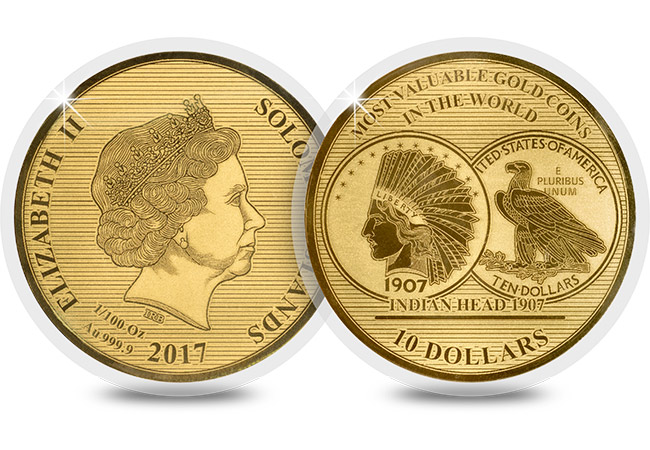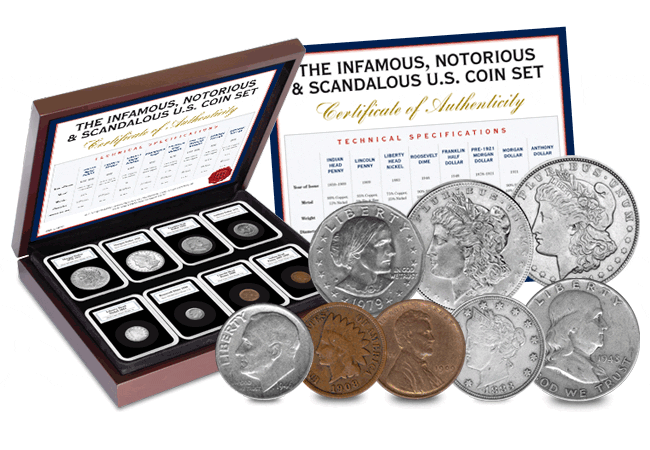American coins
Discover the coins that built the British Empire
The East India Company is living proof of Sir Walter Raleigh’s (1614) prophetic words: “whosoever commands the sea, commands the trade, whosoever commands the trade of the world commands the riches of the world and consequently the world itself,” as they rapidly became a trading force to be reckoned with.
And coins were one of the key ways the company managed trade across the globe.
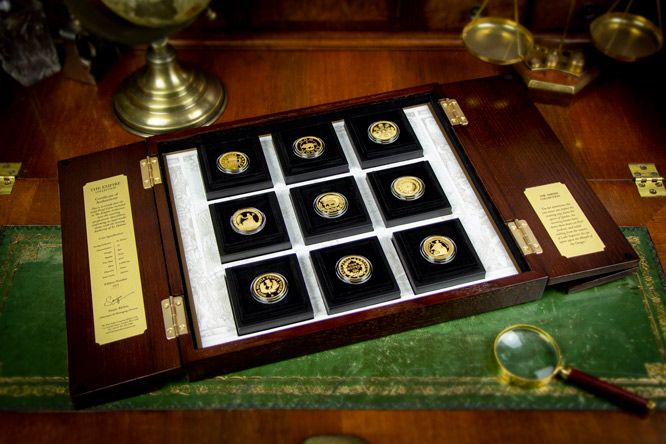
At its peak the EIC was single-handedly responsible for half the world’s trade, including cotton, silk, spices, opium and tea.
Remarkably, the East India Company is still trading today. And they have just authorised a set of limited edition Gold coins paying tribute to the most important coins in their history.
Here is the story behind the coins…
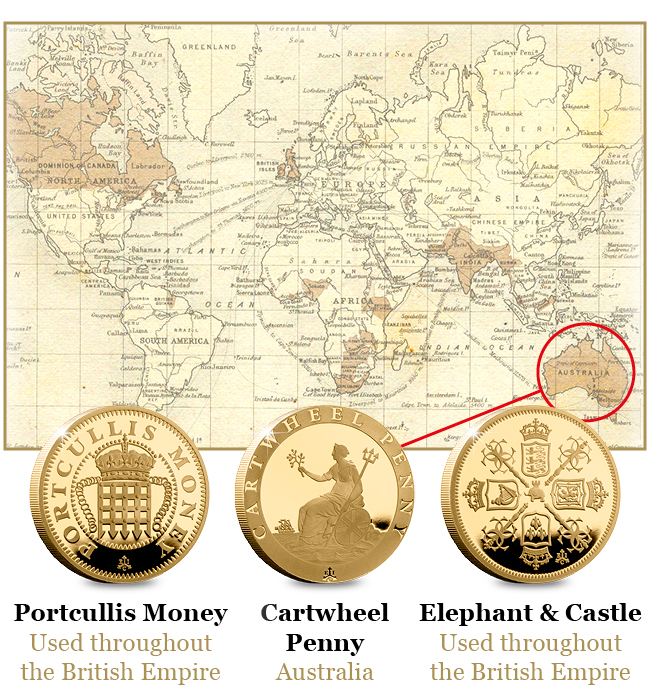
Portcullis Money – 1601 (Throughout the Empire)
Ordered by Queen Elizabeth I to facilitate increased commerce on behalf of the British Crown and to compete against the widely used Spanish Real. These were the first coins issued for the British Empire outside of England’s normal coinage.
The Cartwheel Penny – 1797 (Australia)
The Cartwheel Penny was the first British coin to be exported to Australian Colonies. It was introduced to help curb Britain’s chronic coin shortage which was impacting economic growth. Specially designed to prevent counterfeiting, and the thick rim and inscription led to the pennies being informally named ‘The Cartwheel Penny’.
The Elephant and Castle Guinea – 1663 (Throughout the Empire)
The guinea is regarded as the most successful trade coin, exponentially increasing British and local trade wherever it was introduced. This Guinea was the first British machine-struck coin, and adopted its name from where the gold was mined from.
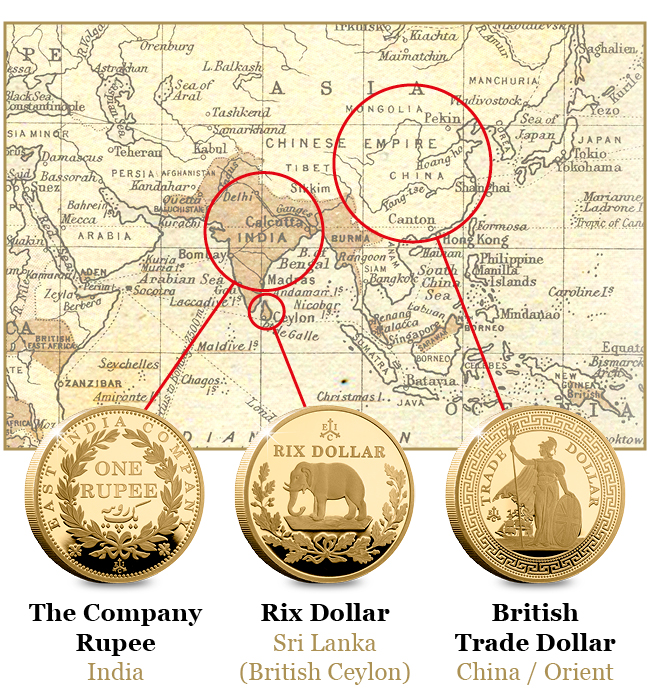
The Company Rupee – 1833 (India)
The Rupee is one of the world’s oldest systems of money. It was adopted by the East India Company upon its arrival in the East, and soon became one of the company’s most important coins and means for trade. In 1833 reforms to the Indian weights and measures led to coinage in India changing from the Sicca to the standard ‘Company Rupee’.
The Rix Dollar – 1821 (Sri Lanka)
Great Britain sought to develop Ceylon’s (Sri Lanka’s) economy and increase trade to and from Europe. As a part of this aim The Rix Dollar was struck specifically for use in Ceylon. Designed by Benedetto Pistrucci, who is also responsible for the now iconic rendition of St. George slaying the Dragon which features on British Sovereigns.
The British Trade Dollar – 1839 (The Orient)
To facilitate the trade of their most lucrative commodities, namely tea and opium a trading post in Canton, China was established. During the Trade Wars Great Britain found itself having to rely more and more on its own silver coinage, and this paved the way for one of the most distinctive silver British coins in numismatic history to be struck: the British Trade Dollar.
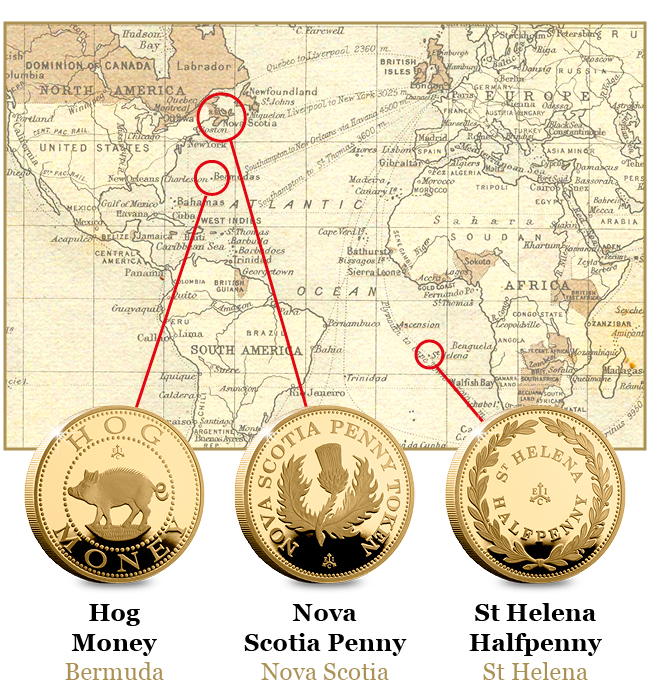
Hog Money – 1609 (Bermuda)
In order to develop Bermuda’s prosperous economy King James I granted permission to mint coins, which resulted in the issuing of Hog Money, inspired by the wild hogs previously introduced to the island, it’s the first English coin to be minted specifically for use in North America.
The St Helena Halfpenny – 1821 (St Helena)
In 1815 St Helena’s economy benefited from the arrival of the former French Emperor, Napoleon, during his second exile, as the famous prisoner brought with him an entourage of British troops, effectively doubling the islands population and prosperity. As the economy swelled, St Helena’s first local coins were introduced.
The Nova Scotia Penny – 1823 (Canada)
Prior to the Canadian Confederation in 1867 many provinces issued their own coinage. However in 1823, without seeking official approval from the Home Office, the province of Nova Scotia ordered the issuing of coins. The coins, issued in denominations of one pennies and halfpennies, contributed to the expansion of local commerce in Nova Scotia.
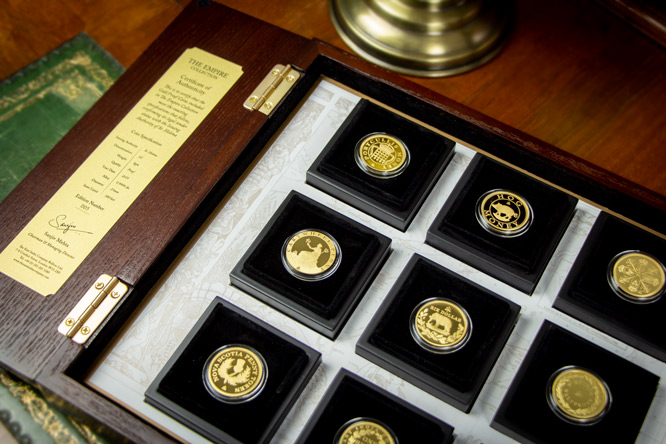
The 2019 Empire Collection
For this exceptional 2019 issue collectors will be taken on a journey to the far flung corners of the world. Retracing the steps of the East India Company, to discover some of the most significant coins which have helped build an empire stretching across three centuries from 1600 to the Victorian Era.
Finished to an exceptionally high standard, the 2019 collection truly represents the global resonance of The East India Company and these significant coins. There is no doubt the 2019 Empire Collection is going to become a future collector priority.
If you are interested…
Out of a Worldwide edition limit of just 100 we have a small stock of the 2019 Empire Collection available. If you are interested in owning a set – please complete the form below and we will contact you directly.
The million dollar coin that caused ‘public outrage’…
Since 1795, the 10-dollar Gold coins in circulation in the United States have been referred to as “Eagles”. These coins were legal tender until their withdrawal in 1933. However, there is one Eagle in particular that has become a numismatic legend.
A presidential intervention
You see, the obverse of the Eagle had long bore the goddess of freedom (Liberty), however in 1907, President Theodore Roosevelt complained to the Secretary of Treasury that US coinage lacked artistic merit.
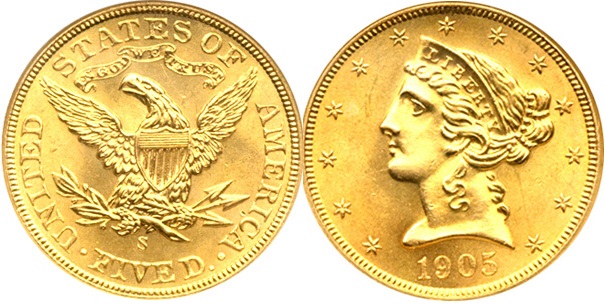
1905 Eagle Coin
As a result, Roosevelt personally commissioned New York City sculptor Augustus Saint-Gaudens to re-design this Gold coin; however, it was certainly not without incident!
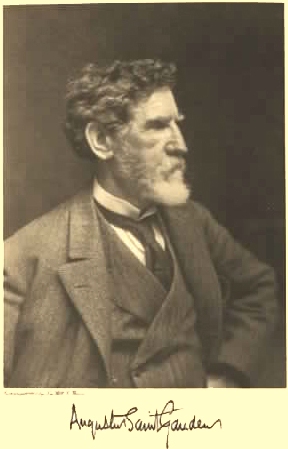
Augustus Saint Gaudens
Firstly, as the coin was designed by a sculptor, rather than a professional engraver, there were a number of issues in production, particularly due to the high relief. As a result, several versions of the coin had to be minted before achieving a sample appropriate for full production and release into circulation.
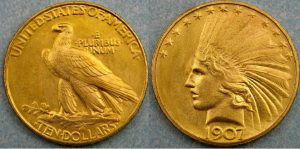
1907 Indian Head Coin
Secondly, Roosevelt felt strongly that a Native American war bonnet should be included in the design as a “picturesque” and “distinctly American” symbol. So, under President Roosevelt’s instruction, Gaudens retained the Liberty profile on the obverse, simply placing a feather headdress on her head. Later, the coin would receive criticism for this absurd addition, with one art historian declaring that it missed out on being “a great coin” due to the President’s interference.
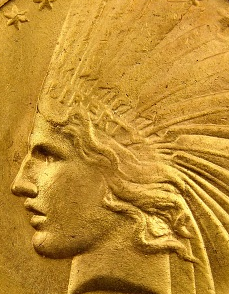
Lady Liberty with Native American War Bonnet
Finally, further issues arose when the motto “In God we Trust” was replaced by “E PLURIBUS UNUM”, which translates to mean “Out of Many, One”. In fact, such was the public outrage, Congress passed a bill mandating its inclusion on any further coins. Mint Chief Engraver Charles E. Barber added the words and made minor modifications to the 1908 design.
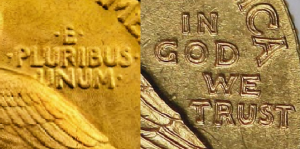
The coins changing mottos
A numismatic legend!
However, as is often the case, the flaws in the original 1907 Indian Head Eagle have made it one of the most desirable coins in the world.
In January 2011, what is probably the best-known example of an Indian Head Eagle, one of only 50 originally minted coins in the rare proof finish, was sent to auction – It sold for an incredible $2,185,000!
If you’re interested…
Today you can own one of the most valuable coin designs in the world…
This pure gold coin weighing just 1/100oz is an affordable way of owning one of the most valuable coin designs in the world – the 1907 USA Indian Head.
Click here to secure yours today >>
America’s most infamous coins
Every coin tells a story. But few more than America’s eight most notorious coins…
Right now the U.S. collectible coin market is an absolute minefield. It is the most competitive coin collecting market in the world. In fact, every one of the top ten most valuable coins of all time is from the U.S.
Some of these coins date back to the 1800’s and all of them are extremely famous. Let me tell you why…

The Indian Penny – featuring a not-so-Native-American!
Indian Head Penny (1859-1909)
The Indian Head Penny is famous for celebrating Native Americans, but it actually doesn’t show a Native American.
According to legend, designer James B. Longacre used a portrait of his 12 year old daughter, Sarah, wearing a headdress. It is, however, more likely that the portrait was based on a classical Greco-Roman statue Venus Accroupie (Crouching Venus).
Either way, the ‘Indian’ is not a Native American! The obverse features the head of Lady Liberty wearing a headdress, while the reverse depicts a wreath as well as the words ‘One Cent’ and a shield in the middle at the top of the coin.
Morgan Silver Dollar (1878-1921)

The design inspired by a school teacher…
For the new silver dollar, designer George T. Morgan decided to portray Liberty as a goddess, inspired by Philadelphian school teacher, Anna Williams who had a fair complexion, Grecian nose and golden hair. Morgan eventually persuaded Anna Williams to sit as the model for Liberty for the obverse of the Morgan Silver Dollar.
In 1878 artists’ models were considered immoral, therefore, Morgan publicly stated that the model was a statue in a Philadelphia museum. Word soon leaked out, however, and it is rumoured that Williams was fired from her teaching job!
‘No Cents’ Liberty Head Nickel (1883)
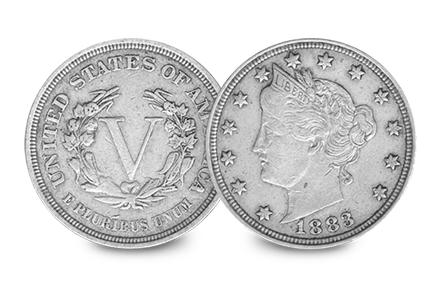
The coin that created an opportunity for crooks
When the new Liberty Head Nickel was issued in 1883, the denomination was nowhere to be seen, instead a large ‘V’ (Roman ‘5’) was on the reverse.
The coins were the size of the $5 gold coin in circulation at the time which created an opportunity for unscrupulous crooks who came up with a cunning plan to pass them off as $5 by gold plating the new nickels and cutting reeds into the edge by hand. The U.S Mint soon became aware and within a few weeks the design was changed to include the word ‘Cents’ under the ‘V’. The ‘No Cents’ coins are also known as ‘Racketeer’ Nickels.
Lincoln Penny (1909)

The first coin to feature Lincoln’s famous motto
Designer Victor David Brenner added his ‘VDB’ initials to the new Lincoln Penny design in 1909 which was issued to commemorate the 100th anniversary of Abraham Lincoln’s birth.
While the public generally loved the Lincoln cent when it was first released, they didn’t like the prominence of Brenner’s initials. The U.S. Mint quickly removed the initials as it appeared as though Brenner was either boasting or advertising. This was the first cent to feature Abraham Lincoln’s motto ‘In God we trust’ on the obverse.
Morgan Dollar (1921)
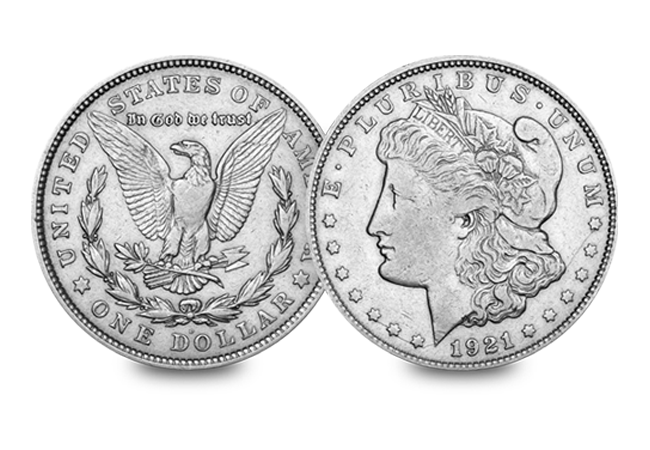
Forever associated with the notorious criminal couple Bonnie & Clyde
When notorious outlaws Bonnie and Clyde were shot and killed by police in 1934, a 1921 Silver Morgan Dollar was recovered from the jacket of Clyde Barrow among other possessions. The outlaw lovers were believed to have committed 13 robberies among other felonies between 1932 and 1934.
The hunt for the duo captured the nation’s imagination during the Great Depression and their fame was heightened by their practice of leaving glamourous photos of themselves at crime scenes.
Even more so now, the 1921 coin is forever associated with Bonnie and Clyde.
Roosevelt Dime (1946)

The stolen design…
In 1945 plans were quickly laid for the introduction of a new coin to honour Roosevelt after his passing. The task was assigned to John Ray Sinnock and coinage began in 1946. Controversy soon arose because sculptor Selma Burke claimed that Sinnock had stolen her design without giving her credit, however Sinnock strongly denied this.
In addition, conspiracy theorists claimed that Sinnock’s initials ‘JS’ (at the base of Roosevelt’s neck) actually referred to Russian leader Joseph Stalin because of Roosevelt’s supposed ‘communist’ learnings.
Franklin Half Dollar (1948)
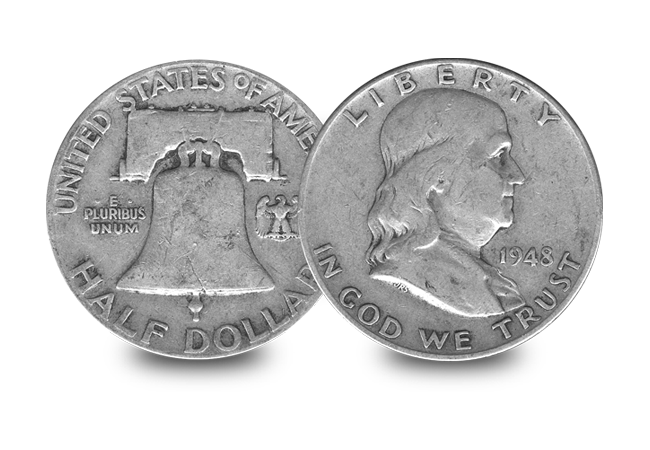
The coin that made a statment
The Franklin Half Dollar was designed by John R. Sinnock and his ‘JS’ initials were again seen by conspiracy theorists as a tribute to Joseph Stalin.
In addition, the crack on the Liberty Bell was controversial, some people saw it as a statement that Liberty in the United States was under threat (despite the fact that the image exactly reflects the bell’s appearance).
Finally, what appears to be a small ‘o’ and large ‘F’ on the reverse (‘oF’ in the United States of America) was rumoured to be a mistake and that the Mint would recall all 1948 coins to correct the ‘error’.
Anthony Dollar (1979)
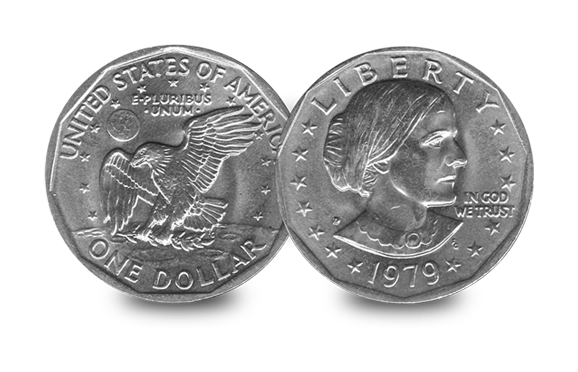
The Dollar that the public refused to use
The Anthony Dollar was revolutionary – the first circulating coin to feature a historical woman. Susan B. Anthony was an author and protest speaker among other titles but best known as President of the National American Suffrage Association. The coin was also the first small-sized Dollar that was issued for wide circulation.
However, it quickly became notorious – and almost universally rejected – because it was the same colour and about the same size as a quarter. Therefore, it was often mistaken for a Quarter, and the public refused to use it! (Interestingly, it is now a sought-after collector’s item.)
You can own all eight of these coins in ‘The Infamous, Notorious and Scandalous U.S. Coin Set’.

